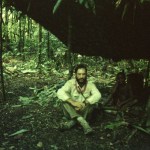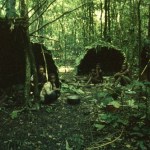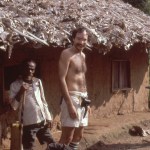Ituri Forest Photo Project
I knew a couple who had spent a lot of time in the Congo in the 1950s. He was doing primatology, and she was the wife of a primatologist. And when she spoke of the Congo or Uganda, where they spent most of the time, she always said two things that always put me off a little. First, she would Uganda and Congo as "Africa" (which is technically correct, but I've yet to hear of someone saying "I'll spend Spring Break in North America" on their way to Cancun) and she'd always say "The thing about Africa is that there's no place to sit down."
It turns out that there are plenty of chairs and…
An Efe forest camp is usually dark and depending on the time of day, dripping from current or recent rain. The Efe live in dome shaped huts which may be more or less complete. A half dome might be a hut that was built quickly, or it might be a hut that was built more openly because it has been hot or it might be only a half dome to allow easier access in and out of the hut by children or individuals with injury or infirmity. A fully domed hut, with a small opening, keeps in more smoke (a fire is often kept in the hut) but it also keeps in the heat and keeps out the rain. So a rainy…
When I first arrived in the Ituri Forest I was shown a camp a group of Efe Pygmies all typically lived in, and told "everyone lives here but the old man and his wife ... he's a bit contentious and there was an argument." Having read all the literature written in English about Pygmies, I was aware of the fact that these foraging people, who moved frequently -- perhaps ten times a year or more -- would often change the composition of their residence groups to reflect forming and breaking alliances among people who often, but not always, lived together. After hanging out in the camp, which was…


